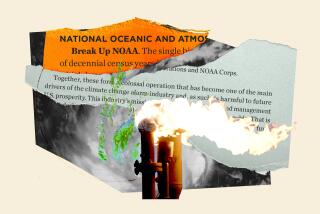Reagan Selects Ex-Scripps Scientist : Peterson Would Be No. 3 at Weather, Oceans Agency
A San Diego scientist who headed a 15-year deep-sea drilling program that transformed understanding of oceans and the ocean floor has been nominated to become chief scientist of the National Oceanic and Atmospheric Administration.
Melvin Peterson, the geologist who ran the federally funded Deep Sea Drilling Project through UC San Diego’s Scripps Institution of Oceanography, was nominated Thursday by President Reagan to the third-ranking position in the giant weather and oceans agency.
If approved by the Senate, Peterson, 58, will become one of the agency’s top spokesmen in matters of science and science policy, overseeing work in such areas as climate and ozone, ocean pollution, acid rain and environmental conservation. Neither Peterson nor NOAA knew when the Senate would take up the nomination.
“When one looks at the ascending importance of environmental sciences today, it’s a field that I feel very strongly about,” said Peterson, who lives with his family in Del Mar. “The more we can do, the better.”
NOAA, which is part of the Commerce Department, has an annual budget of $1 billion and a staff of 13,000. It includes the National Weather Service, National Ocean Service, National Marine Fisheries Service, the satellite service and an office of research.
Peterson’s new job would include oversight of most of the research done through NOAA, including work done through the national climate program office, the ocean pollution program, the estuarine programs office, and the acid precipitation assessment program.
Those programs cover many of the most pressing oceanic and atmospheric issues today, including the depletion of the ozone layer, the environmental degradation of estuaries, acid rain and ocean pollution, a spokesman for the agency said Friday.
“He’s really got a very full plate,” said the spokesman, who asked not to be named.
“I think it’s a great opportunity to do something for our environmental sciences,” said Peterson. He said he hoped “to introduce a greater degree of coordination and synergism so that we can get more done.”
Peterson retired in May from Scripps, where since 1967 he had served as chief scientist, then director, of the drilling project, a kind of space program for exploring the ocean floor through drilling and sediment sampling.
The program, which began as a U.S. effort and expanded to include Europe, Japan and the Soviet Union, is credited with having confirmed the theory of sea floor spreading and continental drift.
Under that theory, molten material rises at mid-ocean ridges, solidifies and spreads laterally in plates, then descends into the earth in submarine trenches. The continents began as a single supercontinent, then drifted apart as a result of sea-floor spread.
The program was also able to show the advent of several glacial periods, changes in ocean circulation, cooling trends in the earth over the last 40 million to 60 million years, and the fact that the Mediterranean Sea went almost completely dry 5 million to 10 million years ago.
Under the program, scientists explored all the oceans except the icebound Arctic, venturing out in 96 two-month “legs” in the Glomar Challenger, a scientific drilling ship designed specifically for the project.
They drilled holes in the ocean floor and recovered samples of sediment for scientific study. Their results were published in 96 hard-bound volumes, totaling more than 100,000 pages, that have been distributed to libraries worldwide.
The program ended in 1983.
Peterson received his Ph.D. in geology from Harvard University in 1960. He joined Scripps as an assistant research geologist that year and was appointed to the faculty in 1962. He served as an assistant professor and then as an associate professor.
More to Read
Sign up for Essential California
The most important California stories and recommendations in your inbox every morning.
You may occasionally receive promotional content from the Los Angeles Times.










